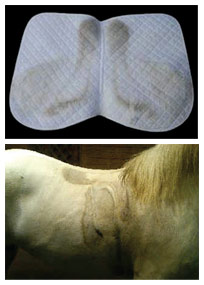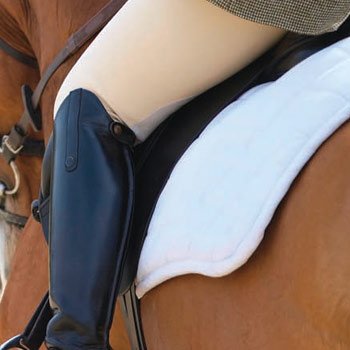How you can use saddle pad dust patterns to determine pressure points and saddle fit.
What your saddle pad looks like after you ride can tell you a lot about its fit. In order to get an optimal sweat/ dust pattern, we suggest you first place a simple, thin white cotton pad under your saddle with a light smattering of “dirt” on your horse’s back. Then, ride your horse at all three gaits (walk/trot/canter) in both directions, in 20-meter circles for about two minutes each. Take your saddle off with the pad and look at both the horse’s sweat pattern, and the dust pattern left on your pad.
 Based on the photo, this saddle fits well. The most dirt accumulates where the most movement is: at the front shoulder (moves up and back) and in the back (horse’s back swings). No dirt should show where the saddle doesn’t come into contact with the horse’s back, such as the gullet or at the transition between sweat flap and panel.
Based on the photo, this saddle fits well. The most dirt accumulates where the most movement is: at the front shoulder (moves up and back) and in the back (horse’s back swings). No dirt should show where the saddle doesn’t come into contact with the horse’s back, such as the gullet or at the transition between sweat flap and panel.
The white triangle under the front part of the saddle also indicates a good position and fit, because in this area the saddle should sit the most quietly without movement. This is where most of the rider’s weight is. This is like the collar on a white dress shirt that gets dirty because there is constant “movement”, air, and dust accumulation; whereas the shirt remains clean on top of the shoulder inside the garment.
Freeing Up The Forehand
In nature, the horse carries the most weight on the forehand. The weight increases even more with a rider on top. The white triangle in the saddle pad indicates that effort has been made to free up the front and back of the saddle so the horse can bring up his back, engaging the hindquarters. For the horse to be able to shift the weight from the forehand to the hindquarters, he must have the ability to bring up his back. Only then can he “pivot” his pelvis and step under with the hindquarters. By doing so, the horse is able to shift the weight from the forehand to the hindquarters, which lets the shoulders come up, allowing freer movement. Most of the movement on the saddle pad should show at the shoulder (front) and at the back, not under the triangle.
The preference is to get horse and rider as close as possible to each other, using the saddle as the interface to allow maximum communication and aids, without impeding performance capability or creating long term damage. The saddle pad should be used only for what it was intended to do – to protect the leather from the horse’s sweat (on an English saddle). In some parts of Europe, people don’t even use saddle pads. Comfort for the animal is in a properly fitted saddle panel, not the pad.
Jochen Schleese is a Certified Master Saddler who graduated from Passier and came to Canada as Official Saddler at the 1986 World Dressage Championships. He registered the trade of saddlery in North America in 1990. Jochen’s lifelong study of equine development, saddle design, the bio-mechanics of horse and rider in motion, and the effects of ill-fitting saddles, led to the establishment of Saddlefit 4 Life in 2005 (SaddleFit4Life.com), a global network of equine professionals dedicated to protecting horse and rider from long term damage.








